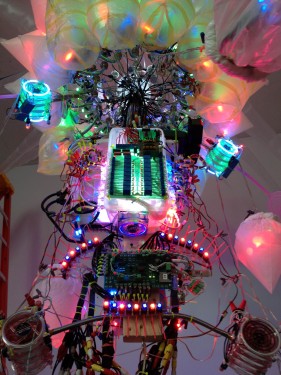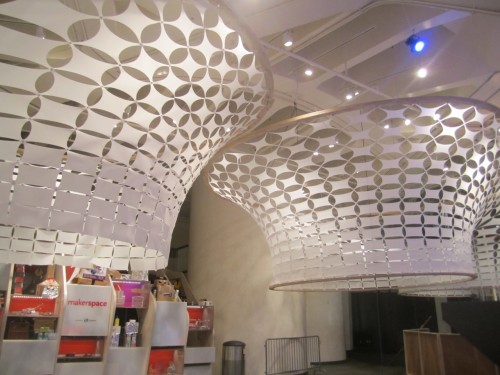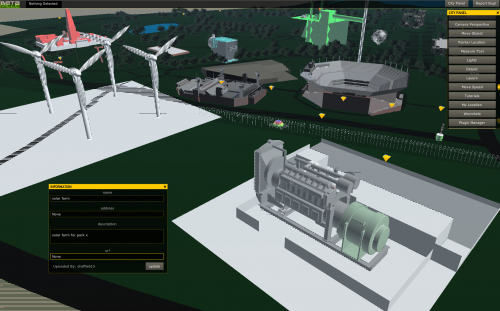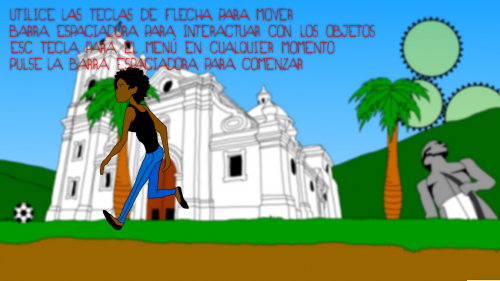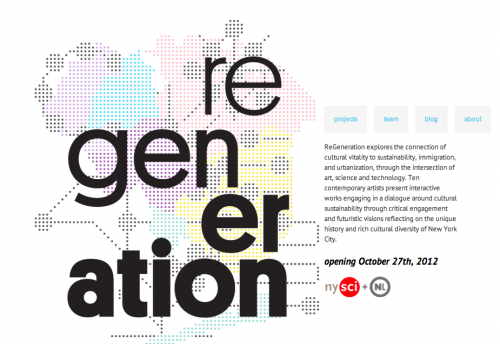ReGeneration to open at New York Hall of Science
Northern Lights.mn and New York Hall of Science Present ReGeneration
Ten artists present their interpretations of cultural sustainability
October 27, 2012 – January 13, 2013
ReGeneration, a new exhibition exploring the relationship between sustainability and cultural vitality, opens October 27 at the New York Hall of Science (NYSCI).
The exhibition includes interactive works by 10 artists that inspire visitors to think about the notion of cultural sustainability through collaborative engagement and futuristic visions built upon the history and traditions of New York’s diverse neighborhoods.
Despite the near ubiquity of the term “sustainability,” there remains significant ambiguity about everything from the actual meaning of the term to overarching solutions to the challenges we face as a community. Technology and behavioral changes including energy production, agriculture, recycling and pollution reduction are all on the table as we work to understand and address the challenge of sustainability.
“ReGeneration is an exhibition about the future,” says NYSCI president and CEO, Margaret Honey. “We challenged the artists to take inspiration from science and imagine a future where we live sustainably, not just in the foods we eat or the materials we use,
but in our fundamental approach to how we view our communities and the interdependence between people and our environment.”
NYSCI produced ReGeneration in collaboration with Northern Lights.mn, a media-oriented art organization supporting artists who work innovatively in the public sphere to foster new relations between citizenry and the built environment. It is curated by Steve Dietz and Amanda Parkes.
“The artists in ReGeneration are change agents,” says Dietz, artistic director of Northern Lights.mn. “The most lasting and sustainable way to change the environment is to change our habits and envision new and exciting possibilities. The artists of ReGeneration each have a unique, engaging and rigorous take on the intersection of art and science in relation to a sustainable, emergent future.”
“As an institution, NYSCI has long explored the intersections of science, art, technology and culture,” says Eric Siegel, NYSCI’s chief content officer, who leads the project team that produced the exhibition. “With ReGeneration, NYSCI explores and celebrates particular indicators and examples of cultural vitality. These engagements can ultimately be adapted to other environments, enabling a network of local practices that helps sustain a regional or larger cultural vitality.”
Artists
BIOMODD, biomodd [nyc4]
In biomodd [nyc4] a team of collaborators led by artist Angelo Vermeulen has created symbiotic relationships between plants and computers. Algae are used to cool computer processors so they can run faster, while the heat that is generated by the computer electronics is used to create ideal growing conditions for a plant-based ecosystem.
Futurefarmers, Ethnobotanical New York
As humans transition from a rural to urban existence, indigenous plant knowledge is being lost and western models of school-based education often do not include traditional skills. Through a mobile structure and workshops, Ethnobotanical New York collects, displays and facilitates the regeneration and production of new and traditional knowledge.
Shih Chieh Huang, 99plus
For 99plus, Huang created glowing, kinetic sculptures of flowers and insects made from materials bought at 99¢ stores in Queens. The items have been integrated with LEDs, computer fans, and microcontrollers to create sculptures that Huang invites visitors to imagine as real life forms “that are adapting to each other, finding ways to coexist, and working together to form a self-sufficient society.”
Marisa Jahn and Stephanie Rothenberg, World’s Fair 2.0
In World’s Fair 2.0, Rothenberg and Jahn collaborated with teenagers to re-envision the World’s Fair to celebrate people and community. NYSCI visitors will take a virtual augmented reality tour to see what the artists imagined.
Scott Kildall, 2049
Using garbage scavenged from a San Francisco landfill, for 2049 Kildall has built imaginary devices that might be needed by a visitor from a future with fewer people and resources. These include an infinite battery, a trans-dimensional mailbox, and an emotional distiller. Kildall will also construct a time capsule called “Imagine 2049” with letters from visitors to the exhibition and from schoolchildren. The time capsule will be buried at NYSCI on January 12.
Zach Lieberman, Face by Face
Lieberman’s Face by Face installation makes faces out of other people’s facial elements. It combines a photo booth, which records video of participants, and a live visualization, which uses custom software to visualize faces using the eyes, noses, mouths, eyebrows and other face parts of previous participants. It is designed to investigate the diverse textures, rhythms and styles of our faces and present an algorithmic, collective portrait of NYSCI visitors.
The Living and SOFTLab, Common Weathers
Design studios The Living and SOFTLab created the exhibition design, Common Weathers, for ReGeneration, which consists of an interactive “cloud” structure, which is suspended from the ceiling and is made from wood and mylar. Lighting elements are embedded within the cloud. The cloud envelops the nine art installations and glows in response to visitors’ text messages.
Carl Skelton, Tomorrow 2.0
To create Tomorrow 2.0, Brooklyn artist Skelton and Joe Frattoni worked with middle and high school students from the Louis Armstrong Middle School IS 227Q in Queens and the Urban Assembly Gateway School for Technology in Manhattan. Tomorrow 2.0 uses Betaville, a collaborative and participatory virtual sketchpad and laboratory platform to focus on an imaginary future for Flushing Meadows Corona Park.
Nick Yulman, New York Immigration Song
New York Immigration Song is a digitally controlled, acoustic sound installation by artist Nick Yulman. It features mechanically actuated piano strings stretched from nodes across a wall-mounted map. Data about immigrant patterns to New York is translated into music, which is played by the piano strings. The resulting music represents the New York City’s changing population and the countries to which it is connected through its residents.
Ricardo Miranda Zúñiga, A Geography of Being/Una Geografia de Ser
Brooklyn artist Zúñiga uses kinetic sculptures, a graphic zine, and a video game to explore the subject of undocumented immigrant populations in the United States. While visitors play the video game, the sculptures react to the game play and help the player. A graphic zine shows the challenges and options that are presented in the video game.
ReGeneration Website
For more information about ReGeneration visit http://regeneration.nysci.org/
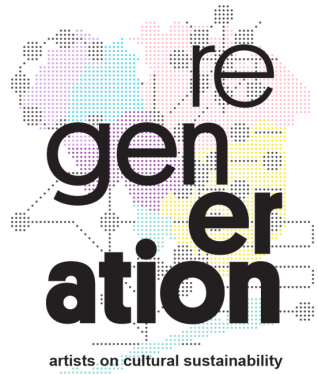
![biomodd [nyc4], BIOMODD - ReGeneration](https://northern.lights.mn/wp-content/uploads/2012/10/biomodd-install-500x375.jpg)

